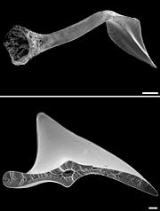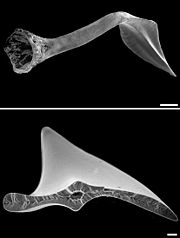
Leptaxis erubescens
Encyclopedia
Leptaxis erubescens is a species
of air-breathing land snail
, a terrestrial
pulmonate gastropod mollusk in the family Helicidae
, the typical snails.
 These snails create and use love darts as part of their mating behavior.
These snails create and use love darts as part of their mating behavior.
The scanning electron microscope
images shown are as follows: the upper image shows the lateral view of the dart, scale bar is 500 μm (0.5 mm). The lower image show the cross-section of the darts; the scale bar is 50 μm.
Species
In biology, a species is one of the basic units of biological classification and a taxonomic rank. A species is often defined as a group of organisms capable of interbreeding and producing fertile offspring. While in many cases this definition is adequate, more precise or differing measures are...
of air-breathing land snail
Snail
Snail is a common name applied to most of the members of the molluscan class Gastropoda that have coiled shells in the adult stage. When the word is used in its most general sense, it includes sea snails, land snails and freshwater snails. The word snail without any qualifier is however more often...
, a terrestrial
Terrestrial animal
Terrestrial animals are animals that live predominantly or entirely on land , as compared with aquatic animals, which live predominantly or entirely in the water , or amphibians, which rely on a combination of aquatic and terrestrial habitats...
pulmonate gastropod mollusk in the family Helicidae
Helicidae
The Helicidae, sometimes known as the typical snails, are a taxonomic family of small to large, air-breathing, land snails. In other words, they are terrestrial pulmonate gastropod mollusks....
, the typical snails.
Anatomy

The scanning electron microscope
Scanning electron microscope
A scanning electron microscope is a type of electron microscope that images a sample by scanning it with a high-energy beam of electrons in a raster scan pattern...
images shown are as follows: the upper image shows the lateral view of the dart, scale bar is 500 μm (0.5 mm). The lower image show the cross-section of the darts; the scale bar is 50 μm.

